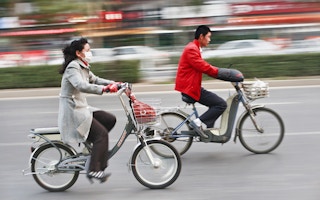Electric bicycles are China’s answer to the Prius because they’re green, they’re zippy and they’re cheap. They’re also emerging as a safety hazard in a country where road accidents are the biggest killer of young people.
As Chinese cities impose car quotas to fend off record pollution, more residents are turning to rechargeable electric cycles. That’s putting a spotlight on e-bikes that snake through traffic as fast as 40 kilometers an hour (25 mph), occasionally mowing down pedestrians or taking a hit themselves.
By some estimates, 200 million Chinese now use e-bikes, a 1,000-fold increase from 15 years ago. About 90 per cent of the world’s e-bikes were sold in China in 2012, according to Navigant Research, a consulting firm, which estimates that another 249 million will be sold there by 2020.
China’s traffic police treat them like bicycles and riders zip alongside cars and trucks — without ever passing road tests.
“This style of transportation is arguably a solution to the world’s mobility problems and China is the testing ground,” said Brent Powis, a Beijing-based road safety consultant for the World Health Organization. “Now we have to look at how to prevent this public health opportunity from becoming a public health risk.”
Research suggests that e-bikes are “involved in crashes at a very high level,” possibly because of their speed, Powis said.
Head injuries
A study conducted by researchers at Peking University and other institutions from October 2010 to April 2011 found that e-bikes were involved in 57 per cent of serious nonfatal road accidents in a rural hospital in Suzhou. Traumatic brain injuries were sustained by 36 per cent of injured riders.
“
E-bikes are a home-grown industry for China. As economic reform drove more of the population to the cities, they were embraced as an essential way of navigating traffic snarls and longer commutes. Rising incomes also allowed residents to upgrade from the bicycle
The government doesn’t give nationwide numbers on costs or other details of e-bike accidents.
Road crashes cost one per cent to five per cent of gross domestic product in developing countries, World Bank president Jim Yong Kim wrote in the foreword of a March report on the growing burden of all traffic injuries.
Jonathan Bental, an Israeli national living in Beijing, bought an e-bike because it was faster, cheaper transportation. A car crashed into him and flung him off two years ago, injuring his foot, he said. He hasn’t decided if he wants to get back on.
“When you’re going at the speeds the e-bikes do, it’s not hard to see why accidents happen,” he said.
While researchers on the Suzhou report say nationwide trends can’t be extrapolated from their study, they found the average length of stay was 10 days and cost 8,229 yuan ($1,321) for hospitalization after traffic accidents.
Less energy
E-bikes are a home-grown industry for China. As economic reform drove more of the population to the cities, they were embraced as an essential way of navigating traffic snarls and longer commutes. Rising incomes also allowed residents to upgrade from the bicycle.
E-bikes now range from bicycles with motors that assist pedaling to more powerful battery-operated scooters. Plumbers, delivery men and office workers alike can walk into a store and buy one for 2,000 to 5,000 yuan ($320 to $800).
Their batteries are re-chargeable, they use less energy, don’t run on petrol and emit less on the road than their motor-scooter cousins.
As pollution has choked Chinese cities, Shanghai and Beijing have taken steps to limit cars and smaller cities are following. Shijiazhuang, capital of the steel-producing Hebei province, proposed in June to restrict vehicle ownership through a lottery.
Speed machines
“Simply put, e-bikes couple very low costs with very high mobility, making them very attractive,” said Christopher Cherry, associate professor in civil and environmental engineering at the University of Tennessee, who has researched the two wheelers in China.
E-bikers often drive on sidewalks, almost creeping up on unsuspecting pedestrians. On a recent, crisp evening, a Bloomberg News reporter encountered five on a walk through a narrow hutong, as Beijing’s old alleyways are called.
The Chinese government in 2010 put road injuries — including casualties from cars, trucks and other vehicles — as the No. 1 killer of Chinese ages 15 to 44.
The World Bank in its March report estimated that China had about 282,576 deaths from road injuries in 2010 — more than four times the figure officially reported.
Calls made to China’s Standardization Administration, its Ministry of Public Security and the Beijing Traffic Management Bureau weren’t answered.
Road safety proponents aren’t pushing for fewer e-bikes — just more regulation. “Helmets, driving lessons, road safety rules — how they tackle this can define the direction of green transportation around the world,” Powis said.
Rob de Picciotto, who’s lived in Beijing for almost a decade, bought an e-bike for 5,000 yuan four years ago. While he hasn’t been injured, he’s seen collisions.
“The solution to all these safety issues is simple and a four-letter word: look,” he said.

















